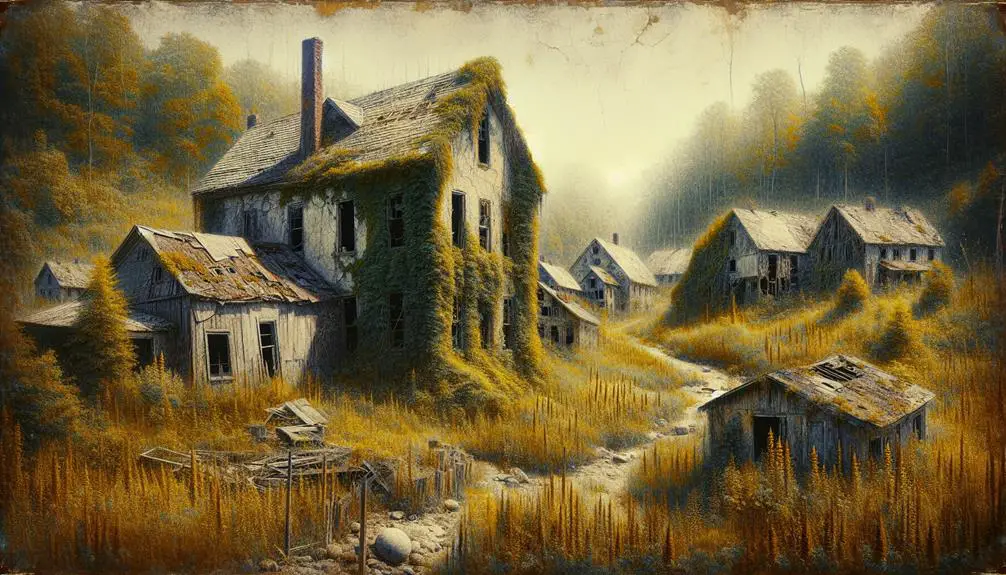Explore the eerie aftermath of failed utopian dreams in New Harmony, Amana, Brook Farm, Silver City, and the Oneida Community. Witness the clashes between idealism and reality, internal strife, and external pressures that shattered these grand visions. These haunted remnants offer insight into the delicate balance required for utopian societies to thrive. The echoes of these failures resonate through time, cautioning against the pitfalls of unattainable perfection. Discover more about the hidden truths behind these utopian legacies and the profound lessons they hold for the curious mind.
Key Points
- Utopian failures like New Harmony, Amana, Brook Farm, Silver City, and Oneida highlight challenges in realizing idealistic visions.
- Internal conflicts, financial difficulties, and societal pressures contributed to the decline of these utopian experiments.
- The ruins of these failed utopias serve as haunting reminders of the complexities and fragility of communal living.
- These failed utopian communities inspire reflection on the balance between idealism and practicality in communal endeavors.
- The legacies of these utopian failures shed light on the aspirations, struggles, and lessons learned from past attempts at creating ideal societies.
Rise and Fall of New Harmony
The rise and fall of New Harmony exemplifies the complexities and challenges inherent in utopian experiments. Founded in 1825 by Robert Owen, New Harmony was envisioned as a utopian community based on principles of equality, cooperation, and education. Initially, it attracted intellectuals, scientists, and artists who shared Owen's utopian visions. However, internal conflicts and financial difficulties plagued the community, leading to its eventual decline.
Despite its noble intentions, New Harmony struggled to maintain a balance between individual freedom and communal harmony. The social experiments conducted within its borders highlighted the inherent challenges of implementing utopian ideals on a practical scale. Issues such as leadership disputes, differing philosophical beliefs, and economic disparities underscored the difficulties of realizing a perfect society.
Ultimately, the story of New Harmony serves as a cautionary tale for future utopian endeavors. It reminds us that while utopian visions may inspire and captivate, the realities of human nature and societal structures present formidable obstacles to achieving lasting harmony.
The Mysterious Ruins of Amana
Amidst the remnants of history lies the enigmatic traces of the once-thriving community of Amana, shrouded in mystery and intrigue. The forgotten relics of Amana stand as silent witnesses to a lost utopia, where communal living once flourished. Founded in the mid-19th century by German settlers seeking religious freedom and a communal way of life, Amana was envisioned as a haven of productivity and harmony.
However, beneath the facade of unity lay internal tensions and external pressures that eventually led to the community's decline. The ruins of Amana now serve as a haunting reminder of the fragility of utopian ideals and the complexities of human nature. Exploring these remnants offers a glimpse into the aspirations and struggles of a bygone era, where dreams of a perfect society clashed with the realities of everyday life.
As you wander through the quiet streets and dilapidated buildings of Amana, you can't help but ponder the legacy of this once-thriving community and reflect on the enduring allure of utopian visions. The mysterious ruins of Amana beckon you to unravel their secrets and contemplate the lasting impact of failed utopias.
Specters of the Brook Farm Experiment
Echoes of collective aspirations and shattered dreams linger within the spectral remnants of the Brook Farm Experiment, a failed utopian venture that continues to intrigue and haunt observers. The concept of communal living and social experiments took center stage at Brook Farm, but ultimately the experiment fell short of its idealistic goals.
Here are some key aspects to ponder when reflecting on the haunting legacies of this historic endeavor:
- Idealistic Vision: The Brook Farm Experiment was founded on the noble idea of creating a self-sustaining community where individuals could live harmoniously and equally.
- Challenges of Implementation: Despite the initial enthusiasm, practical challenges such as financial instability and internal conflicts plagued the community.
- Legacy of Inspiration: The Brook Farm Experiment, despite its failure, inspired future generations to continue exploring alternative ways of living and organizing society.
- Cautionary Tale: It stands as a cautionary tale, reminding us of the complexities and pitfalls that can arise when attempting to manifest utopian ideals in reality.
The specters of Brook Farm serve as a reminder of the delicate balance between idealism and practicality in communal endeavors.
Shadows of the Silver City
Within the historical tapestry of failed utopian experiments, the haunting shadows of Silver City persist as a stark reminder of ambitious visions overshadowed by harsh realities. Founded in the mid-19th century with the promise of a new way of communal living, Silver City was envisioned as a beacon of hope amidst a changing world. However, as time unfolded, the dreams of its founders turned into forgotten whispers, and the once vibrant community now stands as a witness to abandoned hopes.
The allure of a utopian society, where individuals could live in harmony and prosperity, drew many to Silver City. Yet, underneath the surface of unity and purpose lay the seeds of discord and disillusionment. Economic struggles, internal conflicts, and external pressures gradually eroded the foundations of this utopian experiment, casting long shadows over the residents who once harbored grand aspirations for a better future.
Today, the ruins of Silver City serve as a poignant reminder of the fragility of utopian ideals and the enduring impact of failed dreams. The shadows of this once-promising community continue to linger, prompting reflection on the complexities of human nature and the challenges of realizing utopian visions in a world marked by imperfections and uncertainties.
Echoes of the Oneida Community
The legacy of Silver City's failed utopian experiment casts a haunting shadow over subsequent communal endeavors, such as the Oneida Community. When examining the echoes of the Oneida Community, it becomes evident that communal living experiments often endeavor to break free from traditional societal norms.
- Communal Living Challenges
Communal living, although idealistic in theory, frequently faces challenges in practice. The balance between individual autonomy and collective decision-making can lead to conflicts within the community.
- Societal Norms' Influence
The influence of societal norms can seep into communal living experiments, shaping interactions and power dynamics in ways that replicate broader social structures.
- Erosion of Utopian Ideals
Over time, the initial utopian ideals of communal living communities like Oneida can erode, giving way to power imbalances and disillusionment among members.
- Striving for Freedom
Despite facing setbacks, communities like the Oneida Community often aspire to create spaces where freedom of expression and alternative lifestyles can flourish, challenging conventional societal constraints.
Frequently Asked Questions
What Were the Specific Reasons That Led to the Downfall of New Harmony?
You ask why New Harmony fell. Reasons for its downfall include failed communal living experiments, fractured relationships, and unsustainable dynamics. Even now, haunting legacies of Utopian Failures like New Harmony linger, with ghostly remnants and eerie tales.
Are There Any Paranormal Sightings or Ghost Stories Associated With the Ruins of Amana?
Have you heard the eerie echoes of paranormal sightings and ghost stories surrounding the ruins of Amana? Spectral whispers weave through the night, leaving visitors spellbound by the mysterious lore of this haunted site.
How Did the Members of the Brook Farm Experiment Cope With the Failure of Their Utopian Community?
When the Brook Farm experiment failed, members faced a profound psychological impact. Coping mechanisms varied; some sought solace in communal bonds, while others struggled with shattered ideals. Social dynamics shifted, testing group relationships and resilience.
What Lingering Effects of the Silver City Utopian Community Can Still Be Seen in the Present Day?
In the modern era, the silver city utopian community's influences still resonate. Social structures exhibit traces of its communal ideals. Economic shifts reflect a departure from traditional norms. Cultural remnants persist, shaping perspectives and practices.
How Did the Oneida Community's Communal Living Arrangements Impact the Relationships and Dynamics Within the Group?
Living communally in the Oneida Community intertwined your fates. Shared spaces and routines wove your lives together, blurring boundaries. Relationships deepened but tensions simmered as group dynamics shifted, impacting social interactions and causing psychological effects that echoed through time.



